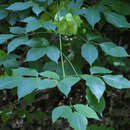en
names in breadcrumbs


Staphylea, called bladdernuts,[2] is a small genus of 10 or 11 species of flowering plants in the family Staphyleaceae, native to temperate regions of the Northern Hemisphere. The highest species diversity is in China, where four species occur.
They are large shrubs, occasionally small trees, growing to 2–5 m tall. The leaves are deciduous, arranged in opposite pairs, and pinnate, usually with three leaflets, but 76–178 mm (3–7 in) S. pinnata and 76–127 mm (3–5 in) S. colchica. The flowers are produced in drooping terminal panicles 5–10 cm long, with 5–15 flowers on each panicle; the individual flowers are about 1 cm long, with the five sepals and petals similar in size and in their white or pale pink colour. The fruit is an inflated papery two- or three-lobed capsule 3–10 cm long, containing a few small nut-like seeds.
Plants of the World Online currently includes:[1]
Some botanists previously included the closely related genus Turpinia in Staphylea.
Several species are grown as ornamental plants for their flowers and peculiar bladder-like fruit. The popular Staphylea × elegans is a hybrid of unknown origin, probably between S. colchica and S. pinnata. The pickled flowers can be served as a side dish in Georgian cuisine.[3]
Staphylea, called bladdernuts, is a small genus of 10 or 11 species of flowering plants in the family Staphyleaceae, native to temperate regions of the Northern Hemisphere. The highest species diversity is in China, where four species occur.
They are large shrubs, occasionally small trees, growing to 2–5 m tall. The leaves are deciduous, arranged in opposite pairs, and pinnate, usually with three leaflets, but 76–178 mm (3–7 in) S. pinnata and 76–127 mm (3–5 in) S. colchica. The flowers are produced in drooping terminal panicles 5–10 cm long, with 5–15 flowers on each panicle; the individual flowers are about 1 cm long, with the five sepals and petals similar in size and in their white or pale pink colour. The fruit is an inflated papery two- or three-lobed capsule 3–10 cm long, containing a few small nut-like seeds.